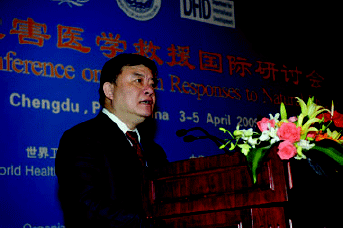Review for renewal—Lessons and thoughts from Wenchuan earthquake medical rescue
Natural disasters represent a great threat to people's health and well-being, both physically and mentally. They also pose threats to economic development in our society. The problem of facing a disaster and minimizing its impact is a common challenge to all nations. Natural disaster medicine is an important issue, and is a part of disaster prevention and rescue. Medical rescue operations for natural disasters have great significance in reducing mortality rate, stopping ongoing disasters, and preventing secondary public health incidents in order to assure public health and safety.
The Wenchuan Earthquake in Sichuan, on May 12, 2008, was the most destructive earthquake ever seen in China for decades, resulting in large areas of devastation and a difficult rescue operation. The rescue operation itself was also the fastest in the history of China, with great recruitment and overall effort. Under the unified command of the Chinese government, with co-operation and support from all governmental departments and international communities, we are, today, happy to announce the complete triumph of the rescue operation to overcome this difficult time. The sight of unified hearts and efforts, at the moment a disaster strikes, stays with us continuously. Hereby, I shall, on behalf of the Ministry of Health of People's Republic of China, express our hearty appreciation to all friends from the national health system and co-operating governmental departments for their hard work and devotion to this rescue operation! We, China, will always owe a great deal to the selfless support from the international community!
The rescue operation for the Wenchuan earthquake was indeed a comprehensive test for competence of the Chinese government after the past 30 years since China opened its doors. It was also a completely unexpected challenge to China's emergency management system and ability to reconstruct. Related departments of health and governmental departments at all levels responded quickly, orderly, and effectively to this disaster, which ensured maximal protection to the public health and safety of people in the disaster zones. This also demonstrates the effectiveness of China's emergency management system and ability to reconstruct. During the reconstruction and restoration phase of emergency rescue operation, the unified central government command was able to enlist co-operation from all departments, as well as the public, to fight against this crisis. Those unaffected provinces came in with devoted hearts to support the disaster areas, which guaranteed the success of the disaster rescue operation. In the face of huge demand from a large population of injured survivors and a severe inadequacy of medical resources, the Chinese government employed the strategy of collectivity to concentrate all the injured, experts, and resources together for rescue and treatment. We also arranged the transportation of 10,000 injured patients to hospitals in unaffected provinces for medical care, which greatly reduced the mortality and disability rate. In terms of disease control, we overcame difficulty and effectively used prevention measures for real-time monitoring of epidemic conditions. Thus, complete coverage of disease control was accomplished in the disaster areas. Up to this date, there has been no report on major epidemics or other unexpected public health issues in the disaster areas.

The medical disaster relief of the Wenchuan earthquake makes us realize that natural disaster is unavoidable, but immediate and effective emergency health management can maximally reduce the risk to human life. Through serious contemplation, we realize that the mechanisms and abilities of all health departments in an emergency situation require further perfection and improvement. We, through development of regulations, construction of emergency health system, and developmental planning, will strive to enhance as national strategy, regional key medical rescue centers, as well as strengthening the on-site emergency health teams with better equipment and resource storage for emergency medical needs.
As is known to all, April 7 is the world health day. The theme for the day this year is “to save life and strengthen emergency responses during crisis”. Its purpose is to appeal to every country to put more emphasis on strengthening their emergency health systems, including crisis management knowledge and medical personnel capabilities during a crisis. From this, we can see that the emergency measures for responding to natural disasters require attention from all levels in a society, especially each part of the health system.
A famous Chinese proverb goes, “review for renewal”, which suggests that we must always look at the past and learn from the work we have done in order to insure a better future. So, we will attempt to completely and scientifically conclude the health work done during the Wenchuan earthquake, and we will able to share and communicate with international communities. We will learn from the cases and experiences of natural disaster medical rescue operations in other nations in order to improve our own emergency health system and reconstruction ability, and hopefully, vice versa. In this way, we can, together as a worldly entity, guaranteeing better health and safety for all human beings.




